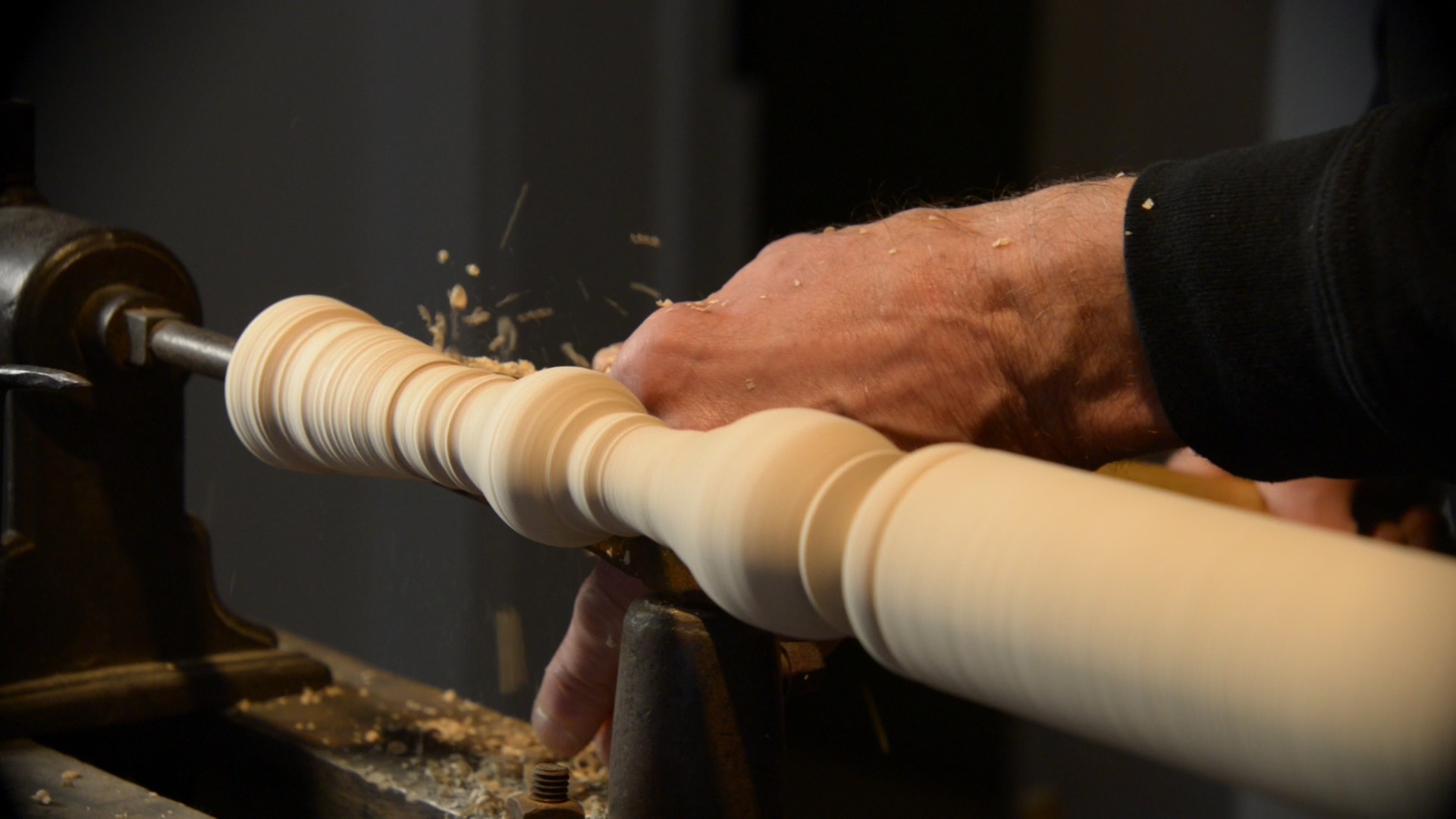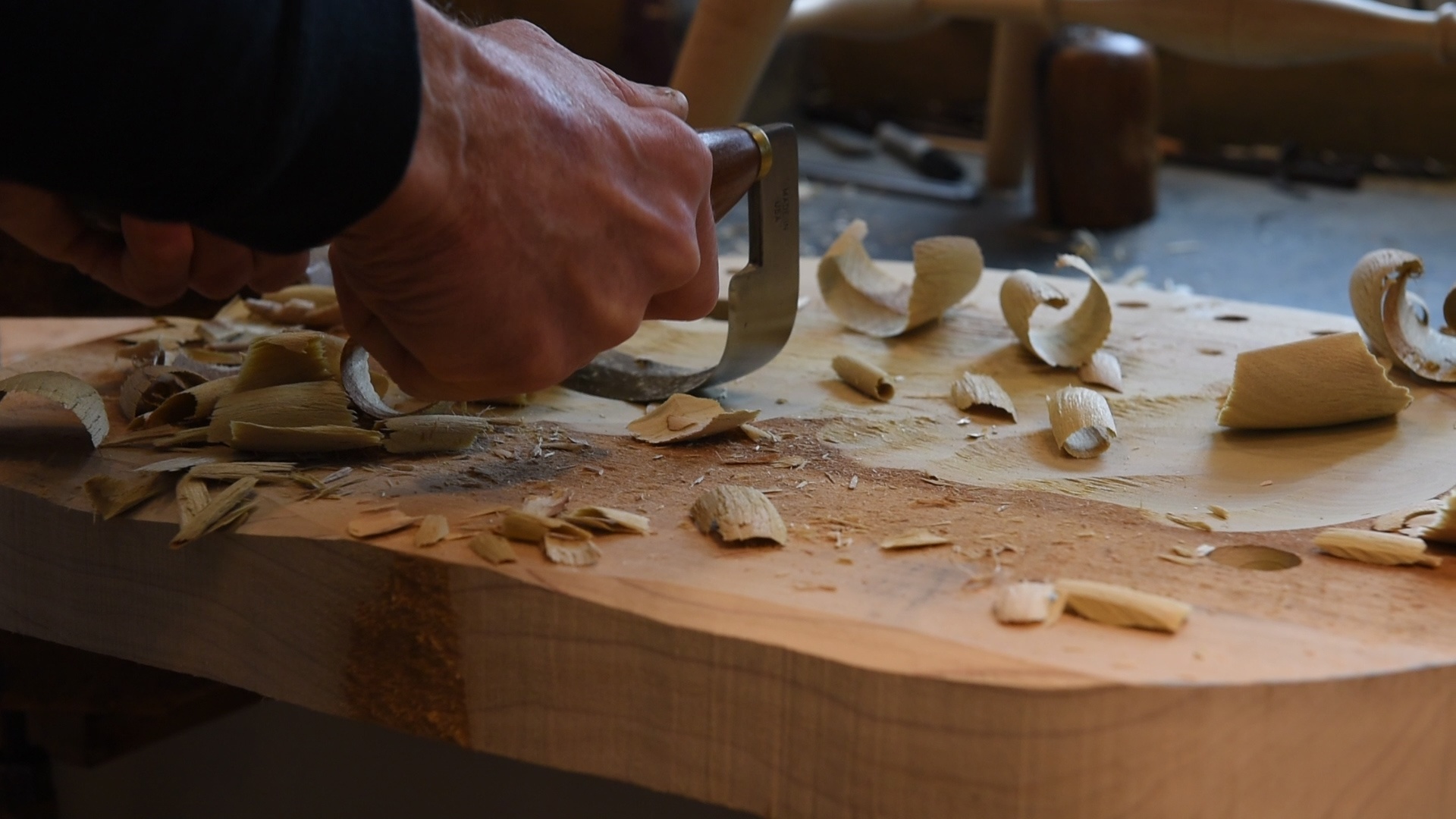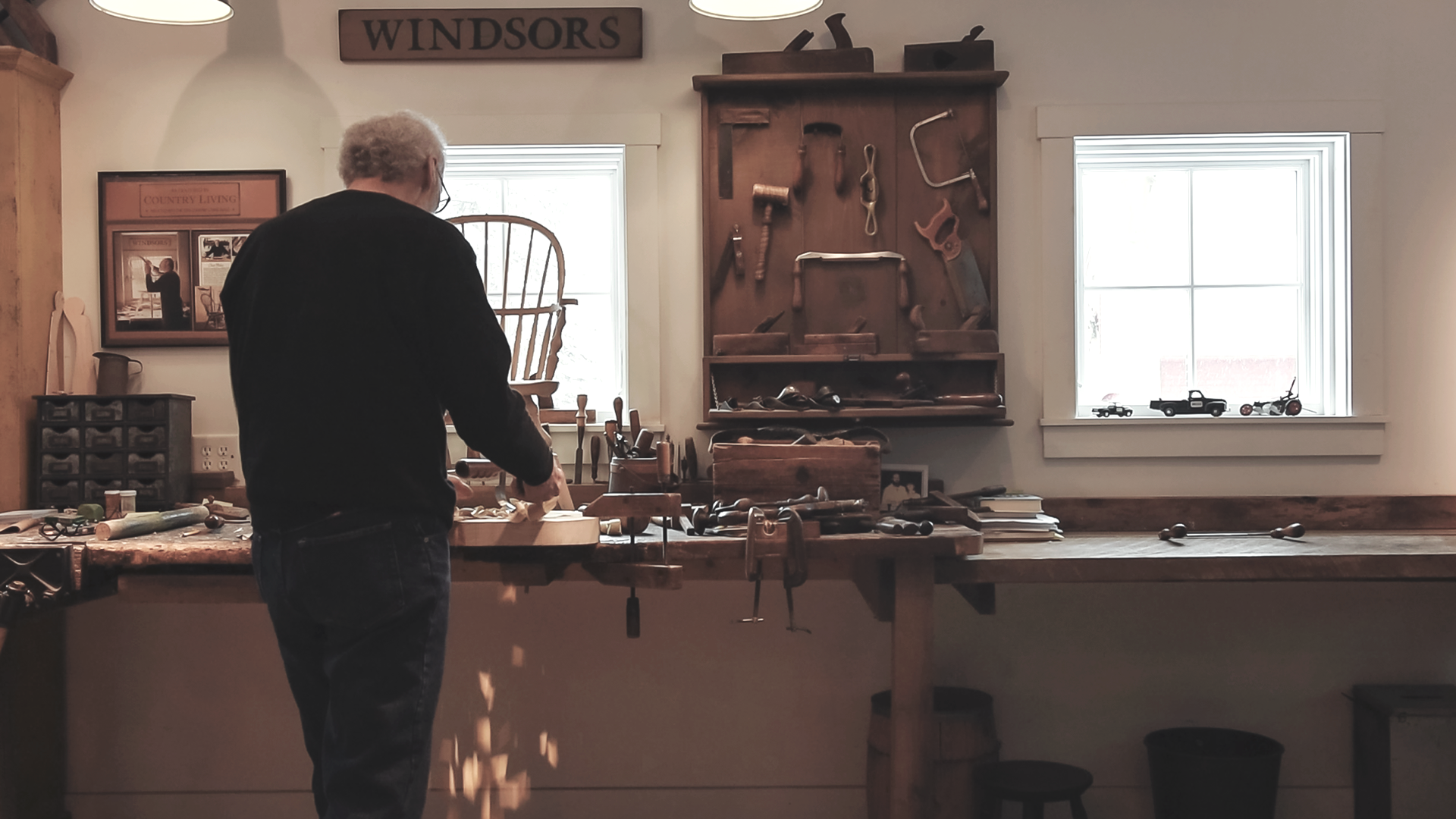Makers 1-on-1 is our original interview series featuring today's makers and DIYers. We're sitting down with new makers every week to learn more about their projects, how they acquire information, their purchase processes, and their passions.
This week, we’re interviewing woodworker and furniture maker Richard Grell from Hudson, OH. Richard has been in the business of crafting traditional windsor chairs from a variety of woods for over 45 years. In his workshop, he uses hand tools, drills, files, and a lathe to build his projects. If your brand sells to woodworkers, this 1-on-1 interview with Richard will give you some important insights that can help you connect with makers like him.
What's your name and what do you do?
My name is Richard Grell and I’m a windsor chair maker.
How and when did you get started making chair?
I got started in 1972. I was self-taught and decided to make this my living, and I have for the last 45 years. I had always worked with wood in my childhood and always worked with hand tools. I was taught woodworking by my grandfather and that was always in the back of my mind, but in the 1960s, everybody thought that aerospace was the place for somebody who was technically minded. I graduated from the Pittsburgh Institute of Aeronautics and worked in the field for a short while, but I decided in the early 70s that this is what I wanted to do [instead] and I never looked back.
What helped you learn the skills you need to be a chair maker?
The skills that are required with hand tools are touch, the ability to anticipate the wood, what it’s going to do, and various moisture contents because I work right from the trees as opposed to buying wood from a lumber store. Having an understanding of the actual wood itself in its wild, growing state and then how to turn it into furniture requires a whole other set of skills. You have to understand that in order to make pieces that are strong, very durable, and beautiful.
The best way to learn for me is as an observer. I’ve always watched very vigilantly when my father or grandfather was doing things with tools or machinery, and I am like a sponge; I would absorb it. So when it comes to learning something new, I did so much research on original chairs that were made in the 1700s, looking at the tool marks and understanding how you can derive the piece you’re trying to create from just the logs. The skills are a lot of observation and being able to teach yourself how to do it.
What are the steps in the process to build one chair?
When you’re building a chair, it’s important to be able to determine the wood right from the trees: what time of year it was harvested and cut, whether the sap is up or down in the tree — those are all critical to start with so that the bending is successful, the legs are turned right, the seat is carved in a way that will be stable. All these elements have to go into the calculation before you even pick up your first tool. Then when you start, it’s a matter of using hand tools — inshave, drawknife, drills, and various tools that are simple and sitting on my bench. You need very few power tools; a lathe is used, but it’s very organic and basic as far as what you do.
I try to make the pieces as efficiently as I can. So if I’m turning on the lathe, and I get into that groove of turning, I will keep turning and turn a whole bucket full of legs or stretchers or parts for the chairs. I get into my zone. When I’m doing the bending and the steamer is going and heating up everything, I will try to bend as many pieces as I have forms to bend around. Seat carving is good exercise because it requires a lot of pulling and strength, and again, you just kind of get into the groove of it. So I tend to make parts a little bit ahead for the chairs, but because they’re always a commission, a lot of times there are variations, so I can’t make them too far ahead.

Why do you gravitate towards hand tools?
I started using hand tools and following the processes because the original chairs had distinct tool marks on them, and they would give you a roadmap to how they were made. People who collect antiques and who are knowledgeable would identify old chairs by the tool marks. Even though they were refined enough that they were nice to look at and smooth, there were still distinct marks left as opposed to something that’s mass-produced. That always drove me, plus the fact that I like the serenity of working with hand tools and having the control over the wood so that I can shape it. You can’t acquire that same effect with power tools. There’s a great deal of therapy that’s gained when you’re using the hand tools and hearing the noise of the blade going across the wood.
Growing up around people in the trades — artists, craftsmen, farmers — you learn to be incredibly self-sufficient. You make things yourself when they break, you fix them. Several of my tools are ones that we make and are available to purchase. They’re unique tools, but they’re of the highest quality anywhere in the world, and I ship them all over and to select people who really appreciate the quality of a fine hand tool. And they have my name on them and the year, and they say made in America, Hudson, Ohio.
What's most important in a product you'd use?
It’s very important that my tools are functional. They need to work. Someone that was doing an assessment of my tools professionally once said that the tools being made by someone who uses them all the time are the best because they actually understand what is needed in a tool. The angles of the edge, the type of edge, the type of metal, the shape of the handles — so that they fit. It’s also nice to have an elegant piece of art to be working with. Also, what’s most important in the selection of the wood for the chairs is the perfect, straight grain without any limbs or knots or deviations. Those deviations become weak spots.
How do you use the internet, as it relates to woodcrafting?
I use the internet for more than I ever imagined I would for just quick research. If I’m interested in a product or a tool, I will quickly Google that and just gather information, read any kind of reviews or anybody who’s used it before. That helps. I don’t know so much about social, but I guess I pick up some information there. I take it with a grain of salt because usually people have some bias, but you take it as an aggregate and it’s part of your information. I still like hands-on things. I like to be able to see them. It’s an old school part of us that it’s hard to buy strictly online, but I’m getting better at it because I’m able to read and research it, so I’ve had pretty good luck.
We have a website. It’s probably a little behind again, but it’s a good tool for people to learn what I’m doing and who I am. I tried to make myself aware of social media and how to take advantage of it in a way to get the message out. There’s sometimes a question in my mind that if something is posted on Instagram, who would say who it’s actually hitting, but I’ll keep trying.
I’m always learning. That’s been pretty much my mantra, that you never stop learning. There isn’t a morning or day that I get up and I don’t learn something from someone. It can be someone unrelated to what you’re doing, but you learn, and those lessons are applicable when you try to put them into your work, your job, your life.

Are manufacturer websites helpful in your research?
They are. It’s important that they provide technical information about their product. They may think that’s lost on somebody that’s not interested the technical, but as someone who was potentially interested in buying something, I would really like to have as much information about that product to help me make an assessment.
Also, seeing tools being used in videos is great. I think that’s helpful. I think the more that products can be demonstrated by someone who is familiar with them and using them as a living — that’s impressive as opposed to somebody who’s using them just to fill space.
How much time does it take to make one chair?
When I start the process on someone’s order, generally it takes a week or so that I’m actually working on that chair. Sometimes I will work on several chairs at the same time, but if we’re actually looking at hours, it’s 40-50-60 hours easily going into one chair. I spend time on the old finishes that I’m kind of known for, so that if you put them in with historical or period pieces and they look like they belong. Of course, my name and the year are on the bottom, and I’m not trying to fool anyone or be fraudulent. That painting does take a lot of time, and I’ve had classes on just my paint finishes and getting that old look with a lot of techniques. So I will sometimes put almost as much time into finishing the chair as I do to actually building them, so a week or two is not uncommon to put into one piece. Some pieces even take a couple months.
What's the most rewarding part of what you do?
I think the most rewarding things that I encounter are the people I have met that have put their confidence in commissioning me to build them something. The pieces that I make with my hands, taken just from a log, become part of their home, their family, their legacy in passing on my work. I’ve had my work be passed on for generations or end up in estate sales and auctions. It’s always interesting to follow. Once you’ve made something with your name on it, it’s out there, barring a fire or something. And the way I make the chairs, they never come apart, so people are going to use them as chairs for long after I’m dust.
I love the solitude of building the chairs and working with the hand tools, especially in the wintertime when I can look out the window. I’m in a warm shop and I’m creating. That’s wonderful and it’s rewarding, but I think that just being able to meet different folks in the world that appreciate the work enough to pay the money and want to have it in their homes is hard to really put a number on.

How do you connect with others woodworkers?
In the last five years, I’ve taken on a little bit of teaching, mainly with what I refer to as Master’s Classes. They’re a one-on-one, and generally with people that are already accomplished woodworkers but they’ve not encountered anything like making a Windsor chair. Many of these folks are professionals who have spent their lives telling other people what to do or educating others, and now they’re in the other seat, and we have a good time. It’s so rewarding to watch someone have the chance to try something new and be able to conquer that and accomplish something that maybe they hadn’t even thought they could.
I’m going to be 70 in a few months here, and my wife gave me the thought that I’ve been at this a long time and have thousands and thousands of hours of experience and I should probably download some of that before my screen goes blank [laughs]. So that’s where teaching became a bit of a factor. I thought I’d be able to share a bit of that knowledge and techniques. A lot of what I do is traditional woodworking, but also my own techniques. They’re a combination of my technical background, my aerospace background, from working with my grandfather early on in wood, metal, and stone. I think many of the people that have taken the classes come out of it saying that this is far more than a woodworking class; it’s been something that really changed their view of how they look at their next project. I’m giving them tools, literally and figuratively, when they leave here. That becomes really kind of neat.
What other projects have you tackled over the years?
The barn is my shop and the place where I create the chairs, but the chairs are always on display for people to see and have been featured in magazines and books and so on with the house because we built the house as a backdrop for the chairs many years ago. My wife creates the beautiful design and I’ve always said what probably what sets my work apart as much as anything is the way it’s presented and shown. That I give 100% of the credit to my wife; she has a great eye and she’s a great designer, and the aesthetic of being able to show the chairs in various settings, not just a traditional period setting. The chair can be thought of as contemporary, neoclassic, and different looks. The Windsor, unlike other heavy pieces of furniture, is very visually open. You see through it and it does not encumber the view when you’re looking out windows or if there’s a lot of glass. It’s an interesting room isn’t hidden by heavy furniture, but you get a perfectly comfortable and functional, great chair.
What's coming up next in tour creative work?
I’m working on sets of chairs right now for clients around the country. I have a few classes that are in the works. I might be doing a few Master’s Classes on occasion for a few individuals. And I’ve got a contemporary Windsor that I’ve been exploring for a few years that we hope to bring to fruition this year. It’s very reminiscent of the period chairs, but it has some contemporary looks that will make it interesting to a new clientele of art collectors and so on. Just keeping busy and enjoying life.




